Electrically Switchable Semiloop Antenna with Polarization and Pattern Diversity
Abstract
1. Introduction
2. Antenna Design
2.1. Antenna Structure
2.2. Even Mode/Odd Mode Switching Circuit
3. Measurement and Simulation Results
4. Conclusions
Author Contributions
Funding
Conflicts of Interest
References
- Piazza, D.; Kirsch, N.J.; Forenza, A.; Heath, R.W.; Dandekar, K.R. Design and Evaluation of a Reconfigurable Antenna Array for MIMO Systems. IEEE Trans. Antennas Propag. 2008, 56, 869–881. [Google Scholar] [CrossRef]
- Raj, J.S.K.; Bonney, J.; Herrero, P.; Schoebel, J. A Reconfigurable Antenna for MIMO Application. In Proceedings of the Loughborough Antennas & Propagation Conference, Loughborough, UK, 16–17 November 2009; pp. 269–272. [Google Scholar]
- Pan, H.K.; Huff, G.; Roach, T.; Palaskas, Y.; Pellerano, S.; Seddighrad, P.; Nair, V.K.; Choudhury, D.; Bangerter, B.; Bernhard, J.T. Increasing channel capacity on MIMO system employing adaptive pattern/polarization reconfigurable antenna. In Proceedings of the 2007 IEEE Antennas and Propagation Society International Symposium, Honolulu, HI, USA, 9–15 June 2007; pp. 481–484. [Google Scholar]
- Boerman, J.D.; Bernhard, J.T. Performance Study of Pattern Reconfigurable Antennas in MIMO Communication Systems. IEEE Trans. Antennas Propag. 2008, 56, 231–236. [Google Scholar] [CrossRef]
- Iqbal, A.; Smida, A.; Mallat, N.; Ghayoula, R.; Elfergani, I.; Rodriguez, J.; Kim, S. Frequency and Pattern Reconfigurable Antenna for Emerging Wireless Communication Systems. Electronics 2019, 8, 407. [Google Scholar] [CrossRef]
- Trinh, L.H.; Le, T.N.; Staraj, R.; Ferrero, F.; Lizzi, L. A Pattern-Reconfigurable Slot Antenna for IoT Network Concentrators. Electronics 2017, 6, 105. [Google Scholar] [CrossRef]
- Dong, L.; Choo, H.; Heath, R.W.; Ling, H. Simulation of MIMO channel capacity with antenna polarization diversity. IEEE Trans. Wirel. Commun. 2005, 4, 1869–1873. [Google Scholar] [CrossRef]
- Al-Yasir, Y.I.A.; Abdullah, A.S.; Parchin, N.O.; Abd-Alhameed, R.A.; Noras, J.M. A New Polarization-Reconfigurable Antenna for 5G Applications. Electronics 2018, 7, 293. [Google Scholar] [CrossRef]
- DS, C.; Karthikeyan, S.S. A Novel Broadband Dual Circularly Polarized Microstrip-Fed Monopole Antenna. IEEE Trans. Antennas Propag. 2017, 65, 1410–1415. [Google Scholar]
- Li, W.; Leung, K.W.; Yang, N. Omnidirectional Dielectric Resonator Antenna with a Planar Feed for Circular Polarization Diversity Design. IEEE Trans. Antennas Propag. 2018, 66, 1189–1197. [Google Scholar] [CrossRef]
- Lin, W.; Wong, H. Wideband Circular-Polarization Reconfigurable Antenna with L-Shaped Feeding Probes. IEEE Antennas Wirel. Propag. Lett. 2017, 16, 2114–2117. [Google Scholar] [CrossRef]
- Zhang, L.; Gao, S.; Luo, Q.; Young, P.R.; Li, Q. Wideband Loop Antenna with Electronically Switchable Circular Polarization. IEEE Antennas Wirel. Propag. Lett. 2017, 16, 242–245. [Google Scholar] [CrossRef]
- Ge, L.; Yang, X.; Zhang, D.; Li, M.; Wong, H. Polarization-Reconfigurable Magnetoelectric Dipole Antenna for 5G Wi-Fi. IEEE Antennas Wirel. Propag. Lett. 2017, 16, 1504–1507. [Google Scholar] [CrossRef]
- Shi, Y.; Cai, Y.; Zhang, X.-F.; Kang, K. A Simple Tri-Polarization Reconfigurable Magneto-Electric Dipole Antenna. IEEE Antennas Wirel. Propag. Lett. 2018, 17, 291–294. [Google Scholar] [CrossRef]
- Wang, K.X.; Wong, H. A Reconfigurable CP/LP Antenna with Cross-Probe Feed. IEEE Antennas Wirel. Propag. Lett. 2017, 16, 669–672. [Google Scholar] [CrossRef]
- Hao, Z.-C.; Fan, K.-K.; Wang, H. A Planar Polarization-Reconfigurable Antenna. IEEE Trans. Antennas Propag. 2017, 65, 1624–1632. [Google Scholar] [CrossRef]
- Hu, J.; Hao, Z.-C.; Miao, Z.-W. Design and Implementation of a Planar Polarization-Reconfigurable Antenna. IEEE Antennas Wirel. Propag. Lett. 2017, 16, 1557–1560. [Google Scholar] [CrossRef]
- Row, J.-S.; Wei, Y.-H. Wideband Reconfigurable Crossed-Dipole Antenna with Quad-Polarization Diversity. IEEE Trans. Antennas Propag. 2018, 66, 2090–2094. [Google Scholar] [CrossRef]
- Zhong, L.; Hong, J.-S.; Zhou, H.-C. A Dual-Fed Aperture-Coupled Microstrip Antenna with Polarization Diversity. IEEE Trans. Antennas Propag. 2016, 64, 4524–4529. [Google Scholar] [CrossRef]
- Wu, F.; Luk, K.M. Single-Port Reconfigurable Magneto-Electric Dipole Antenna with Quad-Polarization Diversity. IEEE Trans. Antennas Propag. 2017, 65, 2289–2296. [Google Scholar] [CrossRef]
- Tang, M.-C.; Wu, Z.; Shi, T.; Ziolkowski, R.W. Electrically Small, Low-Profile, Planar, Huygens Dipole Antenna with Quad-Polarization Diversity. IEEE Trans. Antennas Propag. 2018, 66, 6772–6780. [Google Scholar] [CrossRef]
- Ge, L.; Li, Y.; Wang, J.; Sim, C.-Y.-D. A Low-Profile Reconfigurable Cavity-Backed Slot Antenna with Frequency, Polarization, and Radiation Pattern Agility. IEEE Trans. Antennas Propag. 2017, 65, 2182–2189. [Google Scholar] [CrossRef]
- Wu, F.; Luk, K.-M. A Reconfigurable Magneto-Electric Dipole Antenna Using Bent Cross-Dipole Feed for Polarization Diversity. IEEE Antennas Wirel. Propag. Lett. 2017, 16, 412–415. [Google Scholar] [CrossRef]
- Tran, H.H.; Nguyen-Trong, N.; Le, T.T.; Abbosh, A.M.; Park, H.C. Low-Profile Wideband High-Gain Reconfigurable Antenna with Quad-Polarization Diversity. IEEE Trans. Antennas Propag. 2018, 66, 3741–3746. [Google Scholar] [CrossRef]
- Mak, K.M.; Lai, H.W.; Luk, K.M.; Ho, K.L. Polarization Reconfigurable Circular Patch Antenna with a C-Shaped. IEEE Trans. Antennas Propag. 2017, 65, 1388–1392. [Google Scholar] [CrossRef]
- Chen, S.-L.; Wei, F.; Qin, P.-Y.; Guo, Y.J.; Chen, X. A Multi-linear Polarization Reconfigurable Unidirectional Patch Antenna. IEEE Trans. Antennas Propag. 2017, 65, 4299–4304. [Google Scholar] [CrossRef]
- Row, J.-S.; Huang, Y.-J. Reconfigurable Antenna with Switchable Broadside and Conical Beams and Switchable Linear Polarized Patterns. IEEE Trans. Antennas Propag. 2018, 66, 3752–3756. [Google Scholar] [CrossRef]
- Chang, L.-H.; Lai, W.-C.; Cheng, J.-C.; Hsue, C.-W. A Symmetrical Reconfigurable Multipolarization Circular Patch Antenna. IEEE Antennas Wirel. Propag. Lett. 2014, 13, 87–90. [Google Scholar] [CrossRef]
- Nguyen-Trong, N.; Piotrowski, A.; Hall, L.; Fumeaux, C. A Frequency- and Polarization-Reconfigurable Circular Cavity Antenna. IEEE Antennas Wirel. Propag. Lett. 2017, 16, 999–1002. [Google Scholar] [CrossRef]
- Li, Y.; Zhang, Z.; Chen, W.; Feng, Z.; Iskander, M.F. A Dual-Polarization Slot Antenna Using a Compact CPW Feeding Structure. IEEE Antennas Wirel. Propag. Lett. 2010, 9, 191–194. [Google Scholar] [CrossRef]
- Qin, X.; Li, Y. Compact Dual-Polarized Cross-Slot Antenna with Colocated Feeding. IEEE Trans. Antennas Propag. 2019, 67, 7139–7143. [Google Scholar] [CrossRef]
- BAR64-02V. Available online: https://www.infineon.com/dgdl/Infineon-BAR64-02V-DS-v01_01-EN.pdf?fileId=5546d462689a790c01690f0247ae38fc (accessed on 20 February 2020).
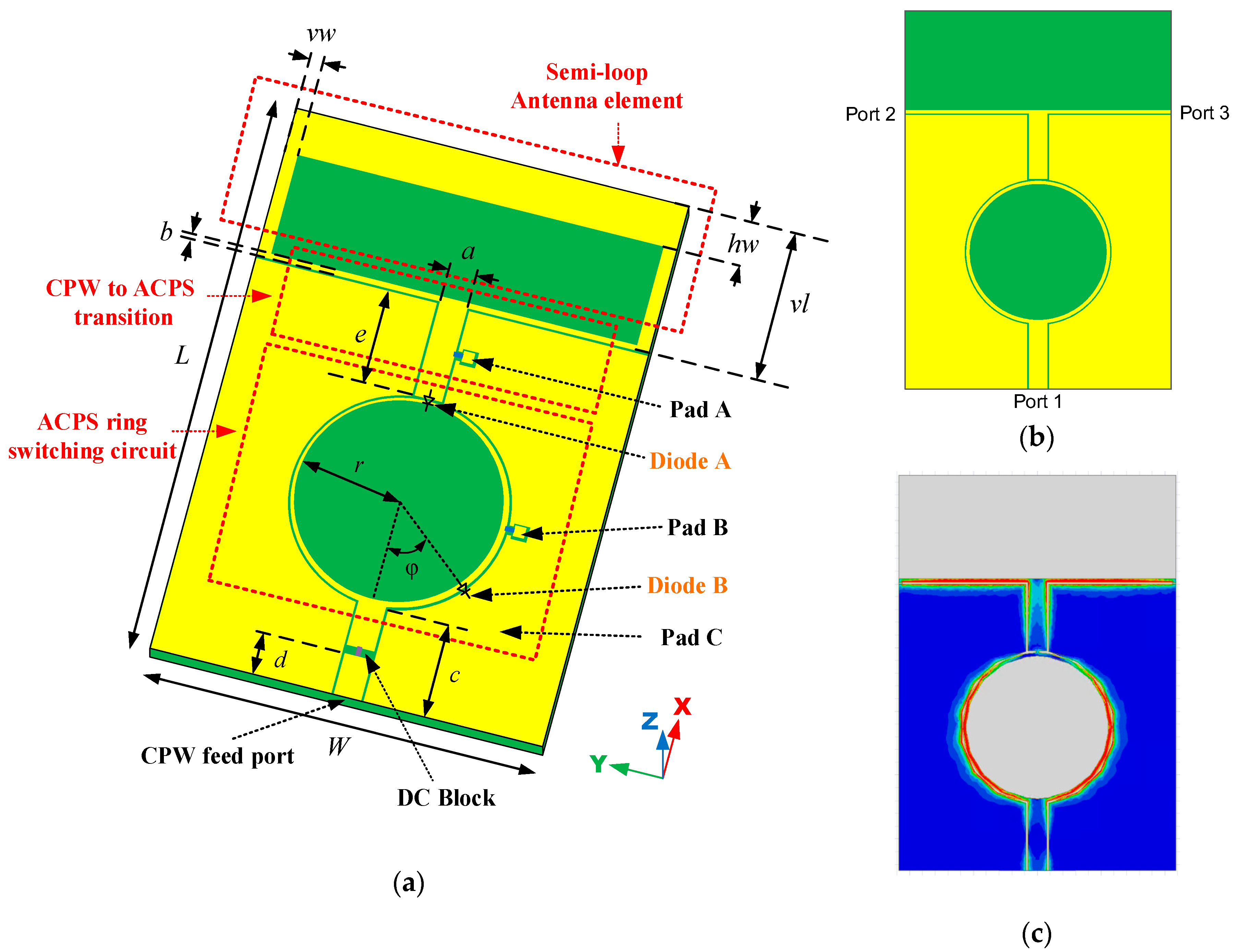
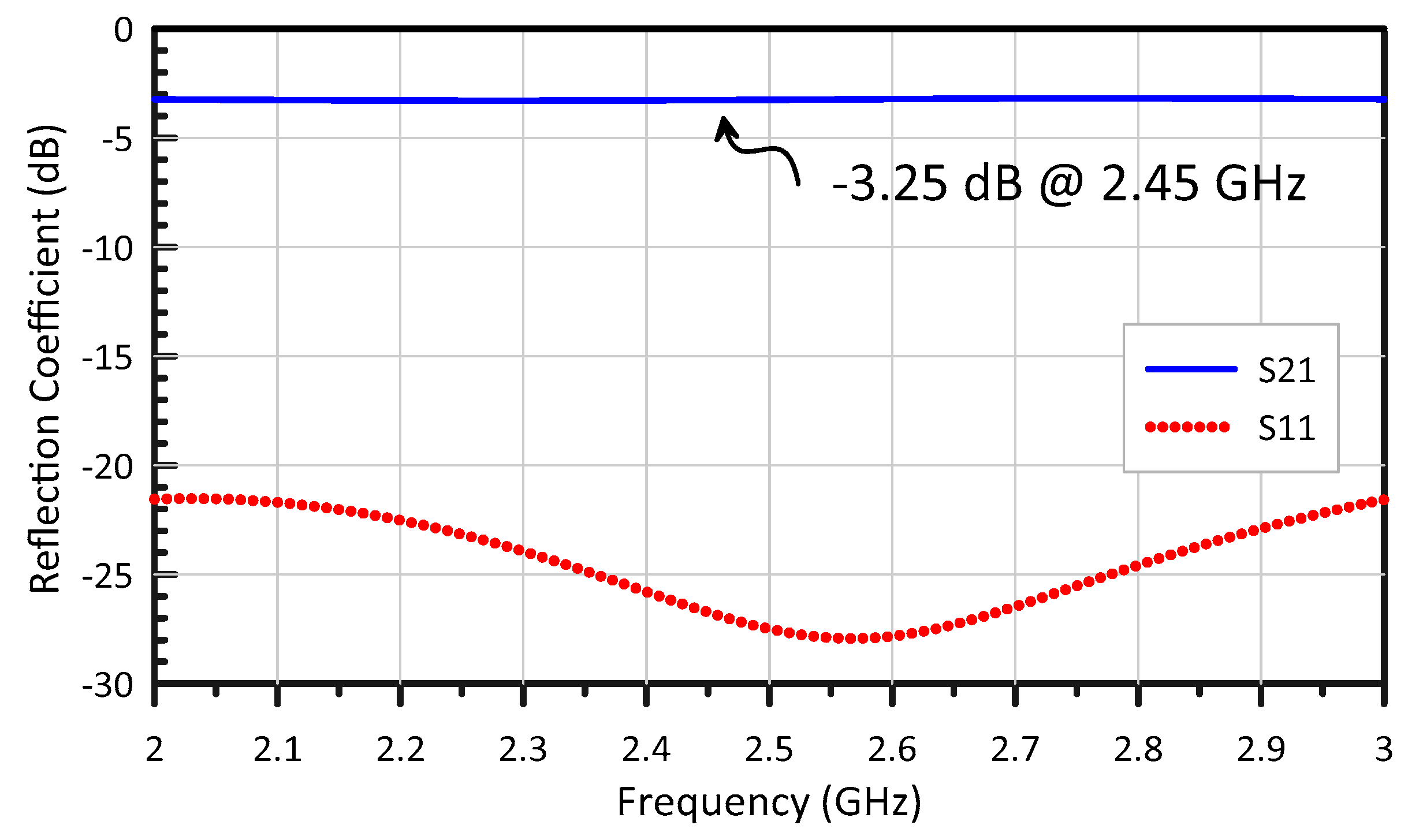
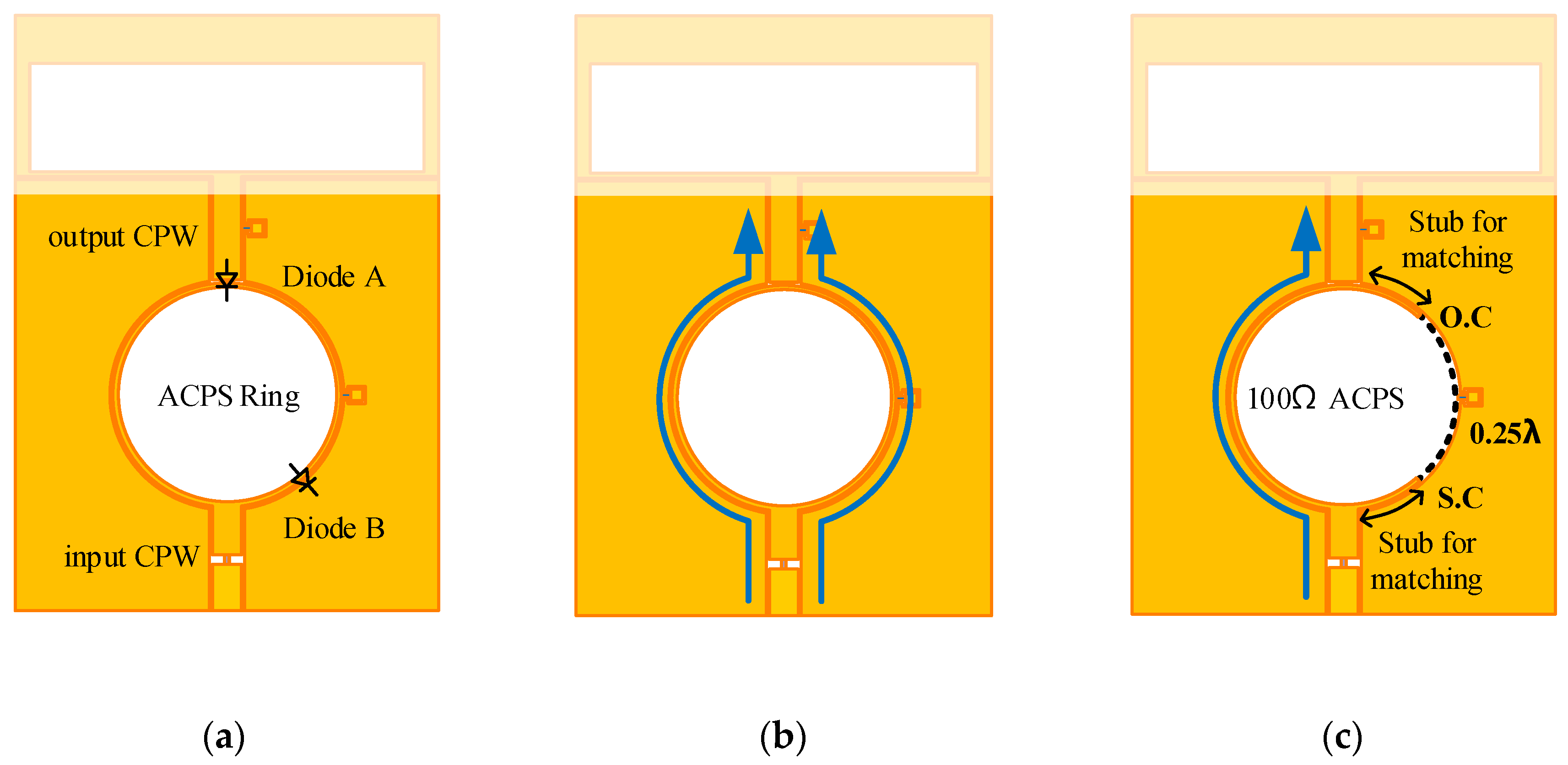
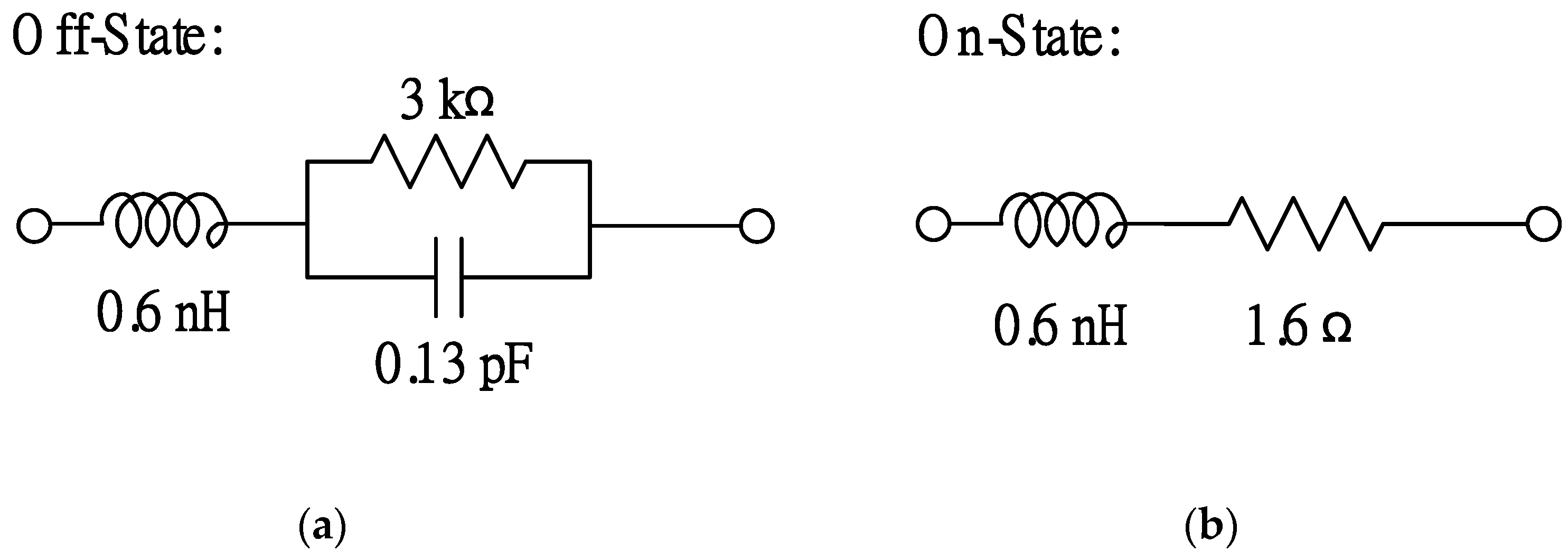

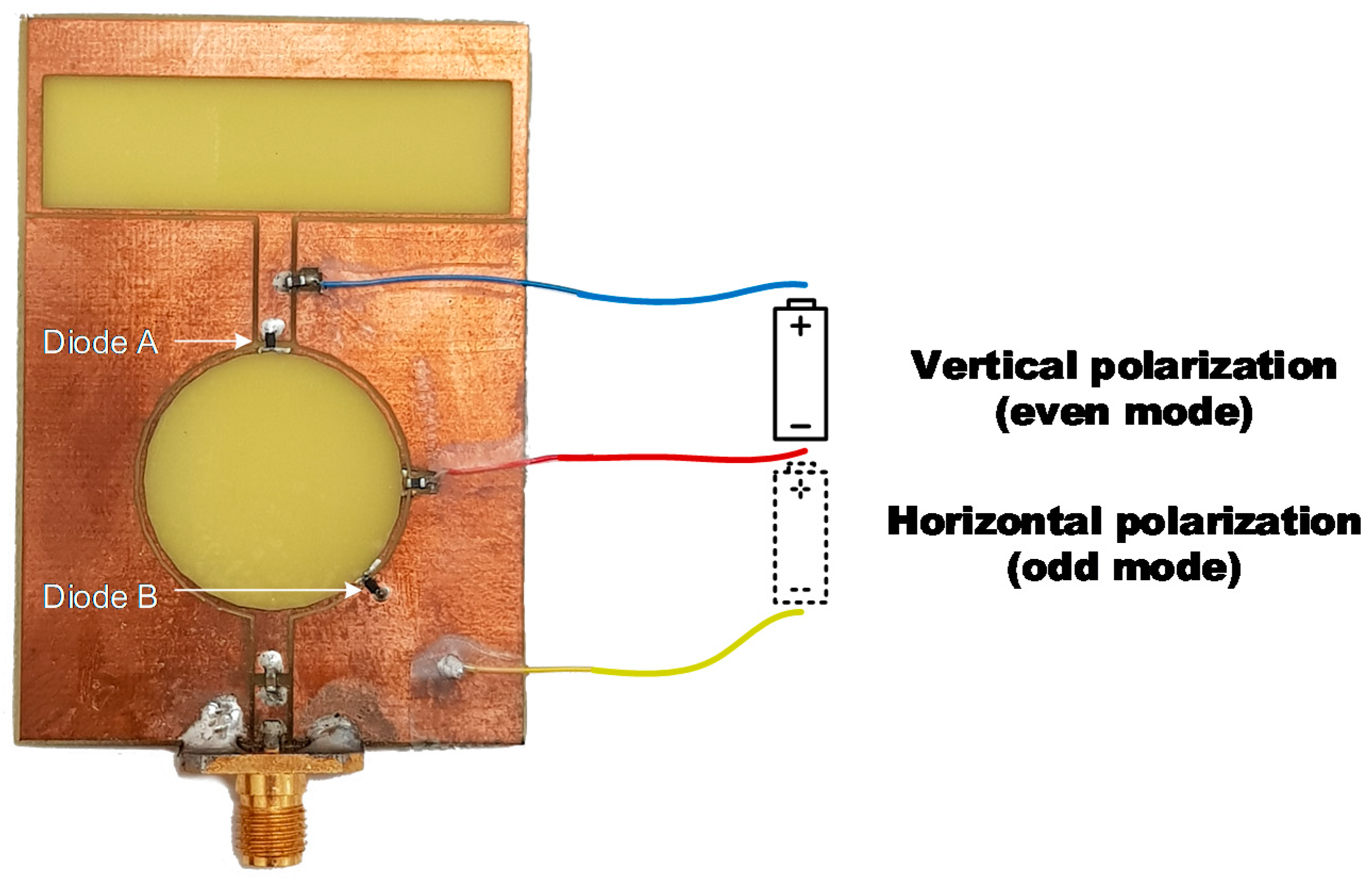
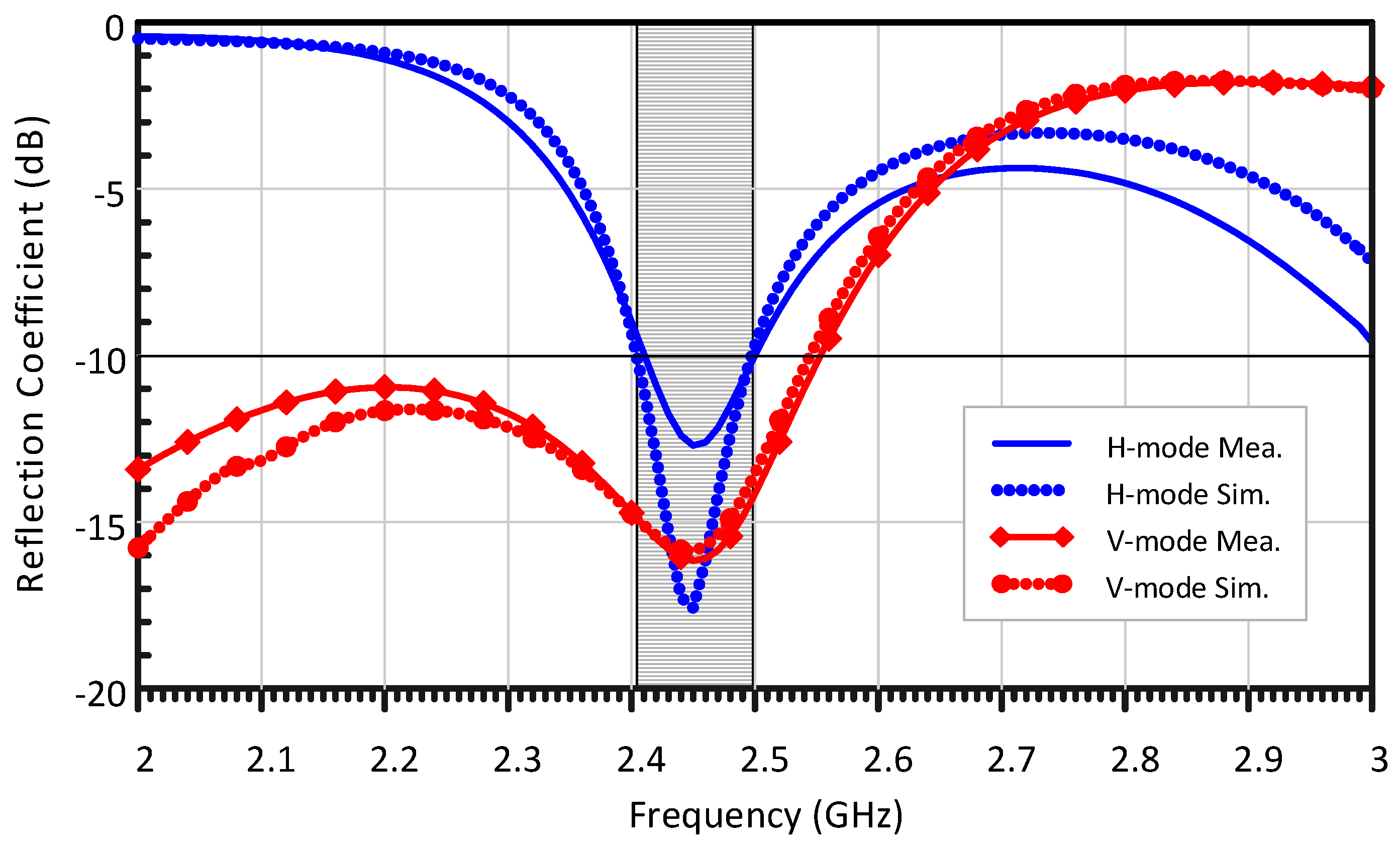
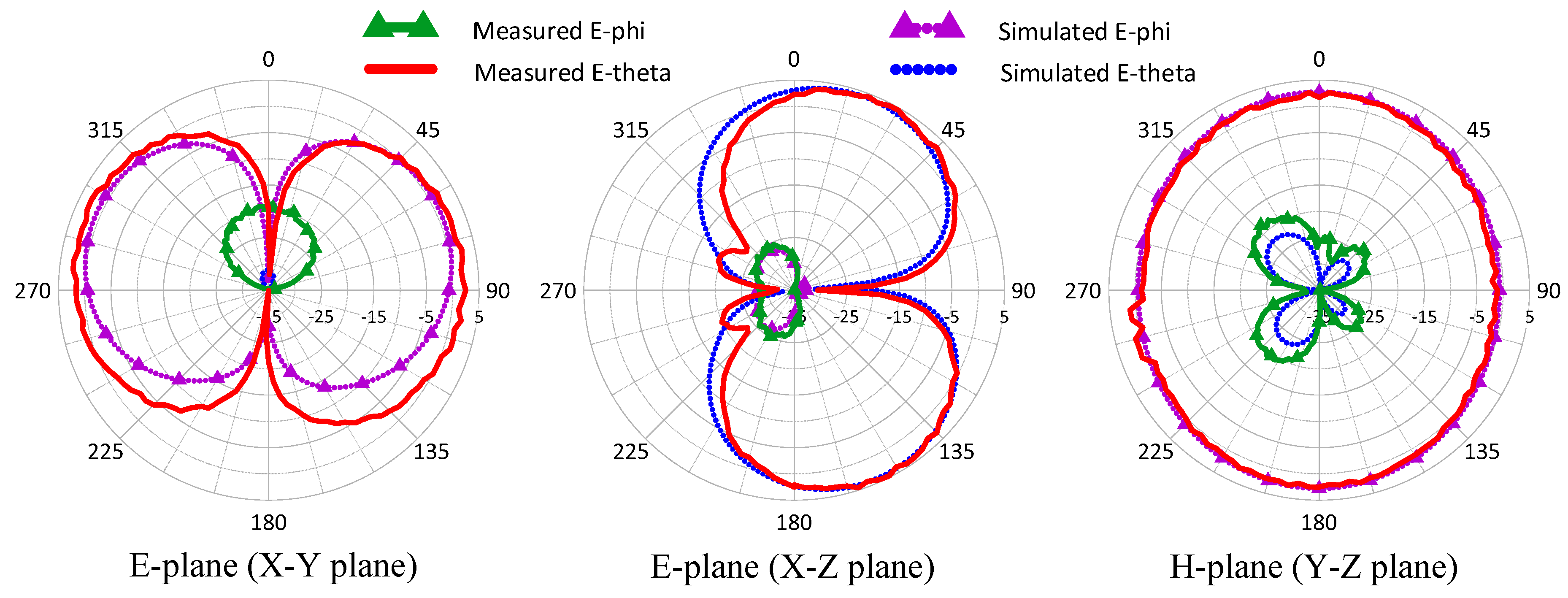
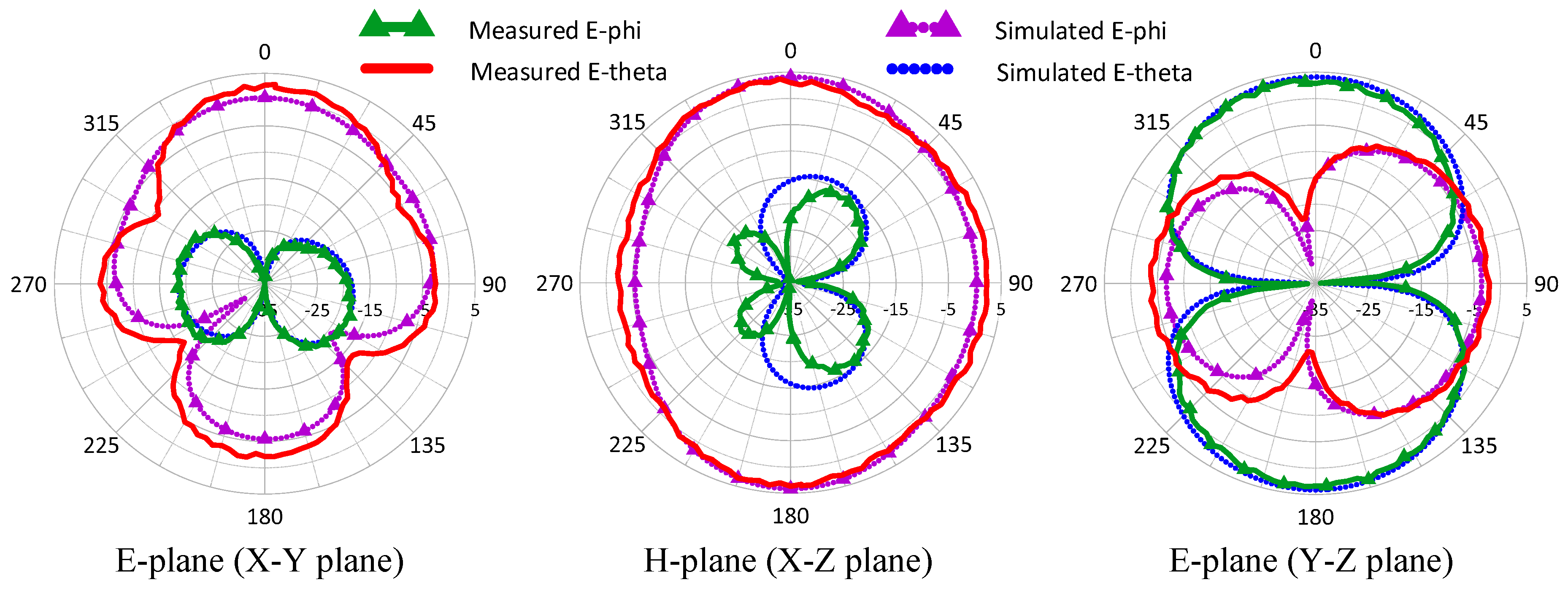
| Parameter | a | b | c | d | e | r |
| Value | 3 mm | 0.3 mm | 10.64 mm | 4.8 mm | 10.64 mm | 11.2 mm |
| Parameter | l | w | φ | vl | vw | hw |
| Value | 62.1 mm | 42 mm | 52° | 16.8 mm | 1.5 mm | 5 mm |
| Pad A | Pad B | Pad C | Diode A | Diode B | Pol. | |
|---|---|---|---|---|---|---|
| Even mode | High | Low | Low | ON | OFF | V |
| Odd mode | Low | High | Low | OFF | ON | H |
| Ref. | Size (λ03) | Structure | Pattern Diversity | No. of Diodes | SW CKT Integrated | Substrate Cost | B.W. (%) | Gain |
|---|---|---|---|---|---|---|---|---|
| [23] | 0.74 × 0.74 × 0.19 | 3D | no | 4 | yes | high | 23.2 | 8 |
| [25] | 1.63 × 1.63 × 0.09 | 3D | no | 2 | no | high | 20 | 7.8 |
| [30] | 0.82 × 0.65 × 0.008 | 2DΔ | no | none | no | low | 27.9/35.4 | 5.21/3.85 |
| [31] | 0.29 × 0.29 × 0.008 | 2DΔ | no | none | no | low | 6 | 2.41 |
| This work | 0.5 × 0.34 × 0.006 | 2D◎ | yes | 2 | yes | low | 12.86/4.91 | 2.62/3.37 |
© 2020 by the authors. Licensee MDPI, Basel, Switzerland. This article is an open access article distributed under the terms and conditions of the Creative Commons Attribution (CC BY) license (http://creativecommons.org/licenses/by/4.0/).
Share and Cite
Chi, Y.-J.; Su, C.-F.; Li, C.-L. Electrically Switchable Semiloop Antenna with Polarization and Pattern Diversity. Electronics 2020, 9, 708. https://doi.org/10.3390/electronics9050708
Chi Y-J, Su C-F, Li C-L. Electrically Switchable Semiloop Antenna with Polarization and Pattern Diversity. Electronics. 2020; 9(5):708. https://doi.org/10.3390/electronics9050708
Chicago/Turabian StyleChi, Yu-Jen, Chien-Fang Su, and Ching-Lieh Li. 2020. "Electrically Switchable Semiloop Antenna with Polarization and Pattern Diversity" Electronics 9, no. 5: 708. https://doi.org/10.3390/electronics9050708
APA StyleChi, Y.-J., Su, C.-F., & Li, C.-L. (2020). Electrically Switchable Semiloop Antenna with Polarization and Pattern Diversity. Electronics, 9(5), 708. https://doi.org/10.3390/electronics9050708





